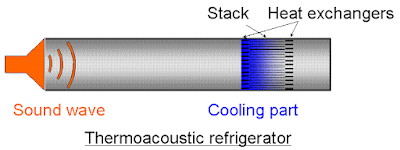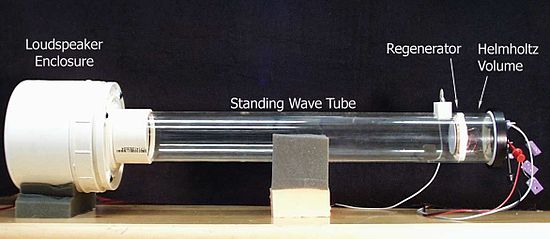Thermo
acoustic have been known for over years but the use of this phenomenon to
develop engines and pumps is fairly recent. Thermo acoustic refrigeration is
one such phenomenon that uses high intensity sound waves in a pressurized gas
tube to pump heat from one place to other to produce refrigeration effect. In
this type of refrigeration all sorts of conventional refrigerants are
eliminated and sound waves take their place. All we need is a loud speaker and
an acoustically insulated tube. Also this system completely eliminates the need
for lubricants and results in 40% less energy consumption. Thermo acoustic heat
engines have the advantage of operating with inert gases and with little or no
moving parts, making them highly efficient ideal candidate for environmentally
safe refrigeration with almost zero maintenance cost.
A thermo acoustic device basically consists of heat exchangers, a resonator, and a stack (on
standing wave devices) or regenerator (on
travelling wave devices). Depending on the type of engine a driver or loudspeaker might be used
as well to generate sound waves. Compared to vapor
refrigerators, thermo acoustic refrigerators have no ozone-depleting or toxic coolant.
Modern research and development of thermo acoustic systems is largely based
upon the work of Rottand later Steven Garrett, and Greg Swift, in which linear
thermo acoustic models were developed to form a basic quantitative
understanding, and numeric models for computation. Commercial interest has
resulted in niche applications such as small to medium scale cryogenic applications.The
aim of this report to study the basics a thermoacoustic refrigerator, its
components and design.
From
creating comfortable home environments to manufacturing fast and efficient
electronic devices, air conditioning and refrigeration remain expensive, yet
essential, services for both homes and industries. However, in an age of
impending energy and environmental crises, current cooling technologies
continue to generate greenhouse gases with high- energy costs.
Thermoacoustic refrigeration is an innovative alternative
for cooling that is both clean and inexpensive. Thermo acoustic devices take
advantage of sound waves reverberating within them to convert a temperature
differential into mechanical energy or mechanical energy into a temperature
differential.Refrigeration relies on two
major thermodynamic principles. First, a fluid’s temperature rises when
compressed and falls when expanded. Second, when two substances are placed in
direct contact, heat will flow from the hotter substance to the cooler one.
While conventional refrigerators use pumps to transfer heat on a macroscopic
scale, thermoacoustic refrigerators rely on sound to generate waves of pressure
that alternately compress and relax the gas particles within the tube.



No comments:
Post a Comment